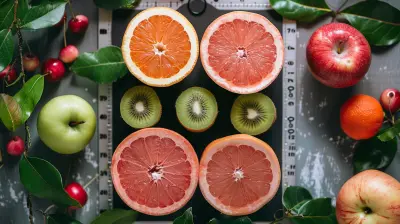Mindful Eating: Avoiding Allergens in Everyday Meals
20 October 2025
Ever find yourself scanning ingredient labels like a detective, hunting for hidden allergens? If so, you’re not alone. Food allergies are more common than ever, and being mindful about what we eat isn’t just a choice—it’s a necessity for many.
Mindful eating is about more than just savoring each bite; it’s also about making conscious decisions to keep our bodies safe and healthy. Whether you have allergies yourself or are preparing meals for someone who does, understanding how to avoid allergens in your daily meals can make all the difference.
Let’s dive into what mindful eating truly means and how you can navigate the tricky world of food allergens without stress. 
What Is Mindful Eating?
Mindful eating isn’t just a trendy term—it’s a lifestyle approach that encourages us to slow down, pay attention to what we consume, and recognize how food affects our bodies. It’s about being present in the moment, appreciating flavors, and making thoughtful food choices rather than eating out of habit or convenience.For those with food allergies, mindful eating involves an extra layer of vigilance. It’s not just about enjoying your food but also ensuring that every bite is safe. 
Common Food Allergens to Watch Out For
Before we get into the nitty-gritty of avoiding allergens, let’s look at some of the most common culprits:- Dairy (milk, cheese, butter, yogurt)
- Eggs (found in baked goods, dressings, and sauces)
- Nuts (peanuts, almonds, cashews, walnuts)
- Shellfish (shrimp, crab, lobster)
- Wheat/Gluten (bread, pasta, baked goods)
- Soy (soy sauce, tofu, processed foods)
- Sesame (found in bread, tahini, and hummus)
These ingredients hide in places you'd never expect. That’s why staying vigilant and reading labels like a pro is so important. 
How to Identify Hidden Allergens in Food
The tricky part? Allergens don't always scream their presence. They sneak into processed foods, sauces, and even “healthy” options.Here’s how to spot them:
1. Read Labels Carefully
Manufacturers often disguise allergens under different names. For example, milk proteins can be labeled as casein or whey, while wheat might appear as hydrolyzed wheat protein. If you’re unsure, a quick online search can help break down mysterious ingredients.2. Watch Out for Cross-Contamination
Even if an item doesn’t list an allergen in its ingredients, it may still be at risk of cross-contact. Foods processed in the same facility as allergens might carry tiny traces. Labels like “May contain traces of nuts” or “Processed in a facility with wheat” are red flags for those with severe allergies.3. Be Cautious Dining Out
Restaurants try their best, but mistakes happen. If you’re eating out, inform your server about your allergies. Ask about food preparation methods—grills, fryers, and utensils might be used for multiple dishes, increasing the risk of contamination.
Mindful Eating Strategies to Avoid Allergens
Avoiding allergens can feel overwhelming, but with a few mindful habits, it becomes second nature.1. Cook More at Home
The easiest way to control what’s in your food? Make it yourself. Cooking at home lets you choose safe ingredients, experiment with allergy-friendly alternatives, and reduce the risk of accidental exposure.2. Plan Your Meals in Advance
Ever been in the middle of a busy day and just grabbed the first thing available? That’s when accidental allergen exposure happens. A little meal prep goes a long way. Keep allergy-friendly snacks and meals on hand to avoid last-minute risky choices.3. Keep It Simple
The fewer ingredients, the better. Whole, unprocessed foods like vegetables, fruits, lean proteins, and whole grains (that are safe for you) make meal planning easier and healthier.4. Educate Family and Friends
If you share meals with others, it’s important they understand your allergies. Whether hosting gatherings or attending events, let people know about your dietary needs so they can accommodate accordingly.Allergy-Friendly Food Swaps
Giving up allergens doesn’t mean giving up delicious meals. Here are some easy substitutions:- Dairy-Free: Swap cow’s milk for almond milk, oat milk, or coconut milk. Use nutritional yeast instead of cheese for a cheesy flavor.
- Egg-Free: Try flaxseed or chia seed mixed with water as egg replacers in baking.
- Nut-Free: Use sunflower seed butter or tahini instead of peanut butter.
- Gluten-Free: Opt for rice, quinoa, or gluten-free pasta instead of wheat-based products.
- Soy-Free: Use coconut aminos as a substitute for soy sauce.
These swaps allow you to enjoy the flavors you love—without the risks.
Creating an Allergy-Safe Kitchen
Your kitchen should be a safe haven, not a danger zone. Here’s how to keep it allergy-friendly:1. Separate Cooking Tools
If someone in your household eats allergens, have separate cutting boards, utensils, and cookware to prevent cross-contamination.2. Label Everything
Store allergy-friendly foods in their own section of your pantry or fridge. Label jars, containers, and snack bins to avoid mix-ups.3. Clean Thoroughly
Washing surfaces and dishes with hot, soapy water is a must. Even a tiny speck of an allergen can trigger a reaction.Eating Mindfully While Traveling
Heading out on a trip? Allergies don’t take a vacation, so it’s crucial to stay prepared.- Pack Safe Snacks: Bring allergy-friendly options to avoid risky airport or convenience store food.
- Research Restaurants: Check menus and reviews for allergy-friendly spots before traveling.
- Bring a Chef Card: A written card explaining your allergies can help restaurant staff understand your needs, especially in foreign countries.
A little planning prevents a lot of stress—and potential allergic reactions.
The Emotional Side of Mindful Eating with Allergies
Let’s be real—food allergies can sometimes feel isolating. Watching others enjoy meals freely while you double-check every ingredient can be frustrating.But mindful eating is also about shifting perspective. Instead of focusing on what you can’t have, embrace what you can. There are endless delicious, allergy-friendly options out there. And the upside? Mindful eating often leads to healthier habits and a deeper appreciation for food.
If allergies ever feel overwhelming, connect with support groups or online communities. You’re not alone in this journey!
Final Thoughts
Mindful eating isn’t just about savoring flavors—it’s about making intentional choices that support your health and well-being. Avoiding allergens takes effort, but with some planning, knowledge, and confidence, it becomes second nature.By cooking at home, staying informed, and embracing allergy-friendly alternatives, you can enjoy delicious meals without stress. Food should be a source of nourishment, not worry—so take control, eat mindfully, and enjoy every bite!
all images in this post were generated using AI tools
Category:
Food AllergiesAuthor:

Madeline Howard
Discussion
rate this article
1 comments
Celine Oliver
Mindful eating promotes awareness of allergens, enhancing both health and meal enjoyment.
October 24, 2025 at 3:07 PM

Madeline Howard
Thank you for your insightful comment! Mindful eating truly plays a crucial role in both health and enjoyment by fostering awareness of allergens.


